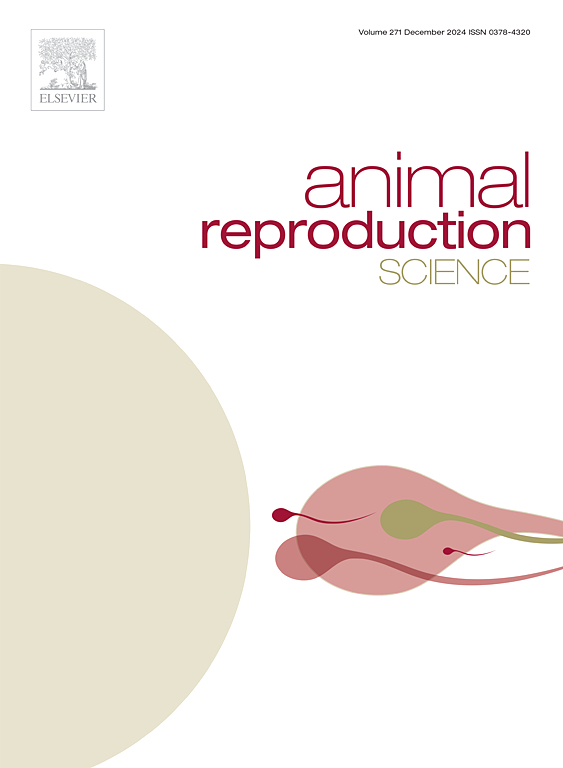Influence of animal temperament on body and reproductive development of beef bulls
IF 2.2
2区 农林科学
Q1 AGRICULTURE, DAIRY & ANIMAL SCIENCE
引用次数: 0
Abstract
Several studies have related reactive temperament to poorer productive and reproductive performance in cattle. However, no studies have aimed to investigate the effect of temperament on sexual development and precocity of male cattle. The objective of this study was to test the hypothesis that reactive animals exhibit delayed sexual development and poorer reproductive performance. For the study, 40 crossbred male cattle (Nellore x Santa Gertrudis) at 12 months were selected. The animals underwent behavioral evaluation and were divided into two groups: calm (CA; n = 24) and reactive (RE; n = 16). All steers were weighed to monitor weight gain, and blood samples were collected to measure cortisol and testosterone concentrations. Semen collections by electroejaculation were performed to determine the onset of puberty and assess sperm quality. Cryopreservation tests were conducted, and the samples were evaluated for kinetics and plasma membrane integrity. Ultrasound examinations assessed testicular development. Additionally, testicular biopsies were performed to evaluate spermatid and spermatozoa ratios. There was a trend toward higher cortisol production (P = 0.07) in RE animals. Higher total (P = 0.03), average (P = 0.07), and daily (P = 0.06) weight gains were observed for CA animals. RE steers produced a higher proportion of cells with minor sperm defects (P = 0.06). Greater vesicular glands development was observed in CA animals (P = 0.01). No effect of temperament was observed on sexual precocity, cryotolerance, or testosterone production. It was concluded that although temperament does not influence age at puberty, reactive bulls exhibit poorer performance in body development, vesicular glands development, and fresh semen quality compared to calm bulls.
求助全文
约1分钟内获得全文
求助全文
来源期刊

Animal Reproduction Science
农林科学-奶制品与动物科学
CiteScore
4.50
自引率
9.10%
发文量
136
审稿时长
54 days
期刊介绍:
Animal Reproduction Science publishes results from studies relating to reproduction and fertility in animals. This includes both fundamental research and applied studies, including management practices that increase our understanding of the biology and manipulation of reproduction. Manuscripts should go into depth in the mechanisms involved in the research reported, rather than a give a mere description of findings. The focus is on animals that are useful to humans including food- and fibre-producing; companion/recreational; captive; and endangered species including zoo animals, but excluding laboratory animals unless the results of the study provide new information that impacts the basic understanding of the biology or manipulation of reproduction.
The journal''s scope includes the study of reproductive physiology and endocrinology, reproductive cycles, natural and artificial control of reproduction, preservation and use of gametes and embryos, pregnancy and parturition, infertility and sterility, diagnostic and therapeutic techniques.
The Editorial Board of Animal Reproduction Science has decided not to publish papers in which there is an exclusive examination of the in vitro development of oocytes and embryos; however, there will be consideration of papers that include in vitro studies where the source of the oocytes and/or development of the embryos beyond the blastocyst stage is part of the experimental design.
 求助内容:
求助内容: 应助结果提醒方式:
应助结果提醒方式:


